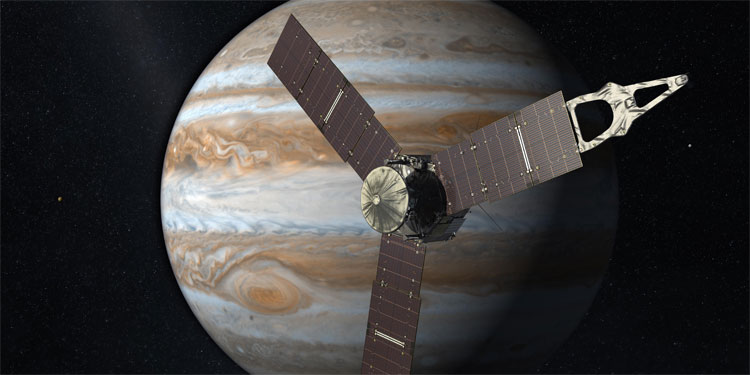Juno spacecraft successfully approached Jupiter for the third time
NASA's Juno spacecraft has successfully implemented the third approach to Jupiter. The time when it came closest to Jupiter was 19:04 on December 11 (Vietnam time) when the train moved at a speed of 207,600km / hour.
On Monday, NASA confirmed that the Juno spacecraft began its third orbit around Jupiter. A round trip around Jupiter's Juno ship lasts 53 days, so the fourth approach will take place on February 2, 2017.
The Juno spacecraft, when approaching the nearest Jupiter, called the perijove point , will be about 4,150km from Jupiter's atmosphere, allowing it to perform extremely accurate calculations of magnetic fields, gravity and other Chemical composition of the planet.
When it comes to the perijove point, 7 of the 8 tools built on Juno will work continuously and send data to Earth for NASA experts to analyze.
According to the chief investigator of the Juno mission, Scott Bolton at the San Antonio Southwest Research Institute, this is the first human mission to thoroughly explore the fascinating school of Jupiter.
"We would love to learn about Jupiter's fascinating school to reveal its past and future giant atmosphere," he said at the press conference.

Simulate the Juno ship when approaching Jupiter.(Photo: NASA).
The only tool that doesn't work when Juno reaches the perijove point is JIRAM. This is an up-to-date tool for scientific data processing processes. JIRAM is expected to start operating from the fourth perijove point, February next year.
Also at the press conference, scientists at NASA said they had intended to reduce the number of days of an Juno orbit around Jupiter from 53 days to 14 days. Shortening the time will make ships use less fuel. However, after a thorough inspection of the machinery, the ship's engine did not allow such a fast flight.
Juno is expected to fly around Jupiter for the next 20 months, during which time it will gather not only what we want to know about Jupiter, but also things we absolutely never thought about, or more distantly related to extrasolar planets in other star systems.
However, even though Juno's machinery is covered by special protection, the Juno life span probably won't last as long as expected. Jupiter releases huge amounts of radiation filled with ionizing particles that erode Juno.
This is unavoidable and unrecoverable, if it is found that Juno is about to end its mission, scientists at NASA will proceed to let the ship fall into Jupiter to ignite and blend into its atmosphere. It avoids falling into the moons of Jupiter that infects bacteria on them.
- The Juno ship first approached Jupiter since flying into orbit
- Juno spacecraft completes halfway to Jupiter
- Juno spacecraft straightens Jupiter
- NASA's Juno spacecraft is about to approach Jupiter on July 4
- The Juno probe successfully approached super typhoon on Jupiter
- Tomorrow, NASA satellite officially approached Jupiter
- The Juno probe sends the first image of Jupiter to Earth
- NASA published a detailed photograph of Jupiter's southernmost surface sent by Juno
- The Juno spacecraft has responded to Moc Tinh
- Photographs of Jupiter's surface look exactly like a water-picture
- A series of wonderful images of Jupiter are sent from the Juno-NASA ship
- NASA escapes freezing in Jupiter's darkness
 Van Allen's belt and evidence that the Apollo 11 mission to the Moon was myth
Van Allen's belt and evidence that the Apollo 11 mission to the Moon was myth The levels of civilization in the universe (Kardashev scale)
The levels of civilization in the universe (Kardashev scale) Today Mars, the sun and the Earth are aligned
Today Mars, the sun and the Earth are aligned The Amazon owner announced a secret plan to build a space base for thousands of people
The Amazon owner announced a secret plan to build a space base for thousands of people